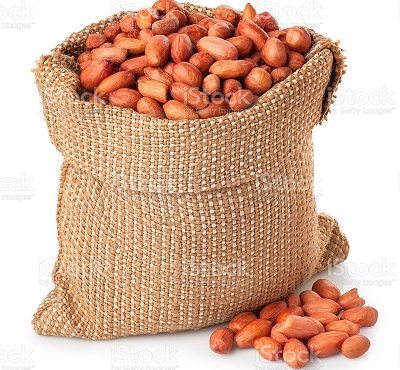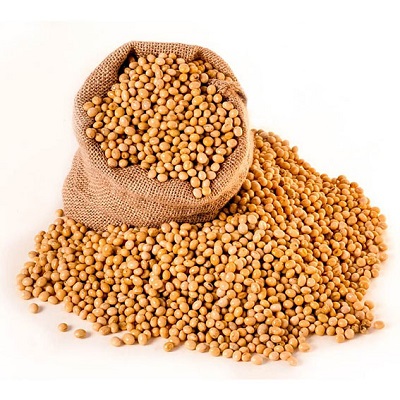Fact sheet about soya bean and groundnut in Ghana

It is interesting to note that:
- Quarshie soya bean variety was released in 2003. Yield potential is 2.0-2.4 t/ ha, days to maturity is 110-115 days, resistant to pod shattering (up to 15 per cent shattering), relatively tolerant to low soil P, seed colour is cream, excellent seed quality, good seed storability, high and stable yield across many environments, tolerant to common soy[1]bean pests and diseases, relatively tolerant to low soil P and trap-crop for Striga hermonthica. It is suitable for Guinea and Sudan Savanna, and transitional zone. It can be processed for oil; can be used as meal for the animal feed industry; can be processed for human consumption and made into products including soy milk, soy flour, soy protein, tofu and many retail food products. Soybeans are used also in many non-food (industrial) products.
- Favour soya bean variety was released in 2012. It has high grain yield up to 3.5t/ha, has high leaf output, has high efficacy with artificial inoculants and it is taller than existing varieties: less losses with mechanical harvester. It is applicable to Guinea and Sudan Savanna, and transitional zone. It produces higher quality soymilk than existing varieties; used for kebab; fixed quantity of biological nitrogen into the soil.

- Suong-Pungun soya bean variety was released in 2012. Early-maturing (85-92 days) attribute, yield potential is 1.5-1.8 t/ ha, has high protein content (42-45 per cent), resistant to pod shattering (less than 5 per cent), excellent seed quality, good seed storability, high and stable yield across many environments, resistant to drought and tolerant to common soy[1]bean pests and diseases. It is suitable for Guinea and Sudan Savanna, and transitional zone. It can be processed for oil; can be used as meal for the animal feed industry; can be processed for human consumption and made into products including soy milk, soy flour, soy protein, tofu and many retail food products. Soybeans are used in many non-food (industrial) products.
- Songda soya bean variety was released in 2012. Maturity period is 110-115 days, yield potential is 1.8- 2.2 t/ ha, pod shattering score: up to 20 per cent, excellent trap-crop for S. hermonthica (as a trap crop) and days to 50 per cent flowering: 45 days. It is applicable to Guinea and Sudan Savanna, and transitional zone. It can be processed for oil; can be used as meal for the animal feed industry; can be processed for human consumption and made into products including soy milk, soy flour, soy protein, tofu and many retail food products. Soybeans are used in many non-food (industrial) products
- Afayak soya bean variety was released in 2012. Yield potential is 2.0-2.4 t/ ha, flower colour is purple, plant height is 40-45 cm, it has medium maturity attribute, resistant to pod shattering (up to 8 per cent shattering), above average tolerance to common soybean pests, resistant to pod shattering and has excellent seed quality. It is suitable for Guinea and Sudan Savanna, and transitional zone. It can be processed for oil; can be used as meal for the animal feed industry Processed for human consumption and made into products including soy milk, soy flour, soy protein, tofu and many retail food products. Soybeans are used in many non-food (industrial) products.
- Oboshie groundnut variety was released in 2012. Its seed colour is brown and potential yield is 2.6t/H. Oboshie matures from 105-110 days. It is applicable to Savannah, forest-savannah transition zone and semi deciduous forest. It has good flavor, sweet taste, confectionery, etc.
- Crops Pion groundnut variety was released in 2017. It is high-yielding and its potential yield is 2.8t/ha. Besides, it is tolerant to rosette and other foliar diseases, aflatoxin-tolerant, high oil content, and early-maturing. It is suitable for forest agro ecology. It can be used for making soup, for oil production while crop residues can be used for hay. Also, residue from oil processing is used as an animal feed and as a soil fertiliser.
- Crops Agbeyeye groundnut variety was released in 2017. Potential yield is 1.9- 2.3t/ha. It matures early, that is, between 90 and 95 days. Have high biomass, tolerant to rosette and other foliar diseases and has high oil content. Crops Agbeyeye is applicable to transition zone and Northern Ghana. It is used for making soup, for oil production while crop residues can be used for hay. Also, residue from oil processing is used as an animal feed and as a soil fertiliser.
- Crops nkatie (groundnut) variety was released in 2017. Potential yield is between 2.2 and 2.4. It matures early, that is, from 90-95 days. Have high biomass, tolerant to rosette and other foliar diseases, high oil content and bold red seed colour. It is suitable for transition zone and Northern Ghana. It is used for making soup, for oil production and crop residues can be used for hay. Also, residue from oil processing is used as an animal feed and as a soil fertiliser.
- Nkatesari groundnut variety was released in 2005. It matures in 115 days and has potential yield of 2.2 ton/ ha. Its oil content is 47 per cent, resistant to both early and late leaf spot disease and has pods yield of 500kg/ha. It is applicable to Guinea and Sudan Savanna. Nkatesari is used for groundnut paste, has better resistance to foliar disease, tolerant to Cercospora leaf spot disease and records low percentage of plants infected by rosette virus disease.
Source: Manual of Agricultural Technologies
developed by
CSIR, MAG and MoFA
Page 61-63 & 52-54












